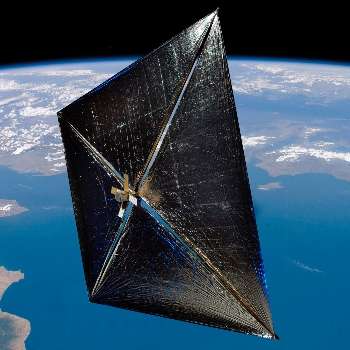Solar Sail

So you've got your nice big spaceship, but you have one big problem - fuel. It's heavy and runs out real quick.
The solution? Build a paper-thin mirrored sail a hundred kilometers across, and hang it in front of your ship - the pressure of light from stars will slowly propel your ship outwards. As you get closer to a star, you get more thrust, and as you get further away, the thrust drops off according to the inverse-square law. Using the thrust to move directly away from the sun is rarely the goal, since the acceleration is low and continuous and doesn't usually equal the sun's gravity.
Like a sailing ship, which uses the contrary force vectors of the water and the wind to choose its direction, a solar sail ship uses the contrary vectors of the sun's gravity (always in) and the sun's light (straight out). A sail ship angles relative to the sun to either increase or decrease its tangential orbital velocity, and therefore the radius of its orbit. In some cases, a solar sail might be used to "hang" a ship or satellite over a star in a place orbital mechanics don't allow (see: Dyson Sphere), but in this case it's more of a solar parachute.
A close cousin is the magnetic sail, a system that uses a huge conductor (kilometers of superconducting wire or a cloud of ionized gas) and a magnetic field to steal kinetic energy from passing solar wind. Since the charged particles streaming from the sun are more massive than photons, this system delivers more thrust, but it requires input energy, and isn't as visually interesting since the "sail" is invisible.
For interstellar voyages, the ship is usually propelled by a giant laser cannon in space shooting at the sail.
Common in hard science fiction, or as Techno Babble for Space Sailing starships.
Film
- The Venture Star in Avatar uses a solar sail to accelerate to its destination several lightyears away. A laser in the solar system provides thrust for the sail to get up to 70% lightspeed. However, the ship uses an antimatter rocket to slow down at its destination.
- Count Dooku in Star Wars: Episode II uses a ship equipped with a (tiny) solar sail to escape from a battle.
- Jim Hawkings' sailboard and the RLS Legacy from Treasure Planet.
Literature
- A derelict alien-built solar sail vessel appears in Decency by Robert Reed. The sail is wider than the Moon, and is punctured from impacts with stray atoms in space. When it impacts with the Earth, all of nothing happens because the sail is so thin.
- The arrival of an alien solar sail vessel in a human colonized system in The Mote in God's Eye starts off the plot.
- The Wind from the Sun by Arthur C. Clarke is about an international race by solar sailing ships from the Earth to the Moon, patterned on America's Cup style yacht racing.
Role Playing Games
- Centauri Knigts uses beam-assisted magsail ships as the only means of travel between Alpha Centauri and the Sol system. They travel at a significant fraction of light speed, but the trip still takes seven years.
- The Jovian Chronicles have solar sail and mag-sail craft as the primary bulk cargo carriers. The trade fleets operate from Mercury, because its central location next to the sun makes it a convenient stopping point. Solar sails are used in the inner systems, but only magsails are practical to reach the Jovian colonies and the asteroid belt. Past that, the solar wind is so diffuse that the Jupiter to Saturn trade relies on fusion-powered ships - fortunately there are big sources of hydrogen at both ends of that run.
Tabletop Games
- Eldar ships in Battlefleet Gothic use solar sails for propulsion